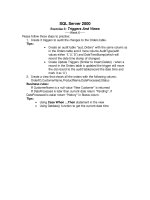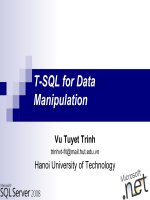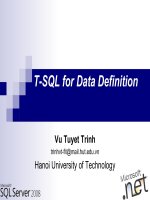SQL Server - Bài5
Bạn đang xem bản rút gọn của tài liệu. Xem và tải ngay bản đầy đủ của tài liệu tại đây (1.54 MB, 84 trang )
Securing Databases &
T-SQL for Data Control
Vu Tuyet Trinh
Hanoi University of Technology
1
MicrosoftMicrosoft
Outline
Understanding SQL Server Security Model
Managing logins, users and roles
Managing Permissions
Data Control Language (DCL) and Security Issues
Implementing Security through Database Objects
Other Security Options
Column Level Encryption
Proxy Accounts
Credentials
MicrosoftMicrosoft
SQL Server Security Model
MicrosoftMicrosoft
SQL Server Security Overview
Layered Security Model:
Windows Level
SQL Server Level
Database
Schemas (for database objects)
Terminology:
Principals
Securables
Permissions
Scopes and Inheritance
MicrosoftMicrosoft
Principals
Securable
Permissions
MicrosoftMicrosoft
Principals, Securable and Permissions
Principal
Individuals, groups, and processes that can request SQL Server
resources.
Logins, Users, Roles, etc
Securable
A Securable is a resource that can be secured
Tables, Views, Endpoints, etc
Permission
Permissions grant principals access to securables
Grant a user Execute rights to a Stored Procedure, etc
SQL 2005 introduces new permissions like Control, Alter Any and
Impersonate
Permissions work in hierarchies
MicrosoftMicrosoft
Security Architecture in SQL Server
2000
Authentication
First stage of security
Identifies users based on login information they provide
Only verifies that users can connect to a SQL Server 2000 instance
Does not provide access to databases and their objects
Authorization
Second stage of security
Occurs when database permissions are checked to determine which
actions a particular user can perform within a database
MicrosoftMicrosoft
Outline
√
Understanding the security architecture of SQL Server
Managing logins, users and roles
Managing permissions
Controlling access with database objects and ownership
chains
Auditing SQL Server
MicrosoftMicrosoft
SQL Server Service Accounts
Local Service Account
Permissions of “Users” group (limited)
No network authentication
Network Service Account
Permissions of Users group
Network authentication with Computer account
Domain User Accounts
Adds network access for cross-server functionality
MicrosoftMicrosoft
Creating Logins
Transact-SQL
CREATE LOGIN statement
Replaces sp_AddLogin and sp_GrantLogin
SQL Server Logins
Windows Logins
SQL Server Management Studio
Setting server authentication options
Login Auditing
Managing Logins
MicrosoftMicrosoft
Managing Logins
Windows Logins
Authentication/Policy managed by Windows
SQL Server Logins
Managed by SQL Server
Based on Windows policies
Password Policy Options:
HASHED (pw is already hashed)
MUST_CHANGE
CHECK_EXPIRATION
CHECK_POLICY
MicrosoftMicrosoft
Database Users and Roles
Database Users
Logins map to database users
Database Roles
Users can belong to multiple roles
Guest (does not require a user account)
dbo (Server sysadmin users)
Application Roles
Used to support application code
MicrosoftMicrosoft
Creating Database Users and Roles
CREATE USER
Replaces sp_AddUser and sp_GrantDBAccess
Can specify a default schema
Managed with ALTER USER and DROP USER
CREATE ROLE
Default owner is creator of the role
SQL Server Management Studio
Working with Users and Roles
MicrosoftMicrosoft
Built-In Server / Database Roles
MicrosoftMicrosoft
Configuring Permissions
Scopes of Securables
Server
Database
Schema
Objects
Permission Settings:
GRANT
REVOKE
DENY
Options
WITH GRANT OPTION
AS (Sets permissions using another user or role)
MicrosoftMicrosoft
Managing Execution Permissions
Transact-SQL Code can run under a specific execution context
By default, will execute as the caller
EXECUTE AS clause:
Defined when creating an object or procedure
Options:
CALLER (Default)
SELF: Object creator
Specified database username
MicrosoftMicrosoft
Data Control Language
GRANT
Used to grant access on an object or a statement to a user.
REVOKE
Used to revoke permissions on a database object
DENY
Used to explicitly deny any permission on any object or statement
MicrosoftMicrosoft
GRANT Syntax
GRANT <permission> [ ,...n ] ON [ OBJECT :: ]
[ schema_name ]. object_name [ ( column [
,...n ] ) ] TO <database_principal> [ ,...n ]
[ WITH GRANT OPTION ] [ AS <database_principal> ]
<permission> ::= ALL [ PRIVILEGES ] | permission [
( column [ ,...n ] ) ] <database_principal> ::=
Database_user | Database_role | Application_role |
Database_user_mapped_to_Windows_User |
Database_user_mapped_to_Windows_Group |
Database_user_mapped_to_certificate |
Database_user_mapped_to_asymmetric_key |
Database_user_with_no_login
MicrosoftMicrosoft
REVOKE Syntax
REVOKE [ GRANT OPTION FOR ] <permission> [ ,...n ]
ON [ OBJECT :: ][ schema_name ]. object_name
[ ( column [ ,...n ] ) ] { FROM | TO }
<database_principal> [ ,...n ] [ CASCADE ] [ AS
<database_principal> ] <permission> ::= ALL
[ PRIVILEGES ] | permission [ ( column [ ,...n ] )
] <database_principal> ::= Database_user |
Database_role | Application_role |
Database_user_mapped_to_Windows_User |
Database_user_mapped_to_Windows_Group |
Database_user_mapped_to_certificate |
Database_user_mapped_to_asymmetric_key |
Database_user_with_no_login
MicrosoftMicrosoft
DENY Syntax
MicrosoftMicrosoft
Example
MicrosoftMicrosoft
Implementing Security through
Database Objects
Securing data with views
Views can be defined to provide either a filtered set of table
columns or a limited set of data rows from underlying tables
A common use of a view is to create a special representation of
a table that does not contain certain sensitive information
MicrosoftMicrosoft
Implementing Security through
Database Objects
Securing data with stored procedures and user-defined
functions
Stored procedures and user-defined functions allow sets of T-
SQL statements to be stored and executed as a single unit
They are typically used to enforce business rules or
perform logic
MicrosoftMicrosoft
Implementing Security through
Database Objects
Controlling access with triggers
Triggers are similar to stored procedures in that they contain
saved groups of T-SQL statements
However, triggers are not called directly, so
permissions cannot be granted directly to use them
They are controlled by insert, update and delete
permissions on the table with which they are
defined
MicrosoftMicrosoft
Understanding Ownership Chains
Ownership chains
Hierarchy of
dependent
objects
Figure 8-12: Ownership chain









